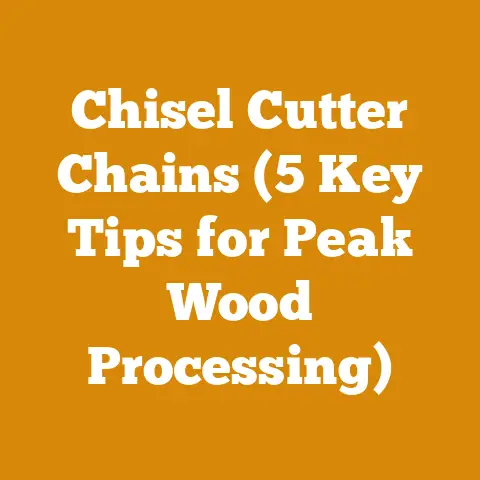Cost of Crushed Stone Per Ton (5 Insider Tips for Wood Processing)
Cost of Crushed Stone Per Ton: An Insider’s Guide for Wood Processing
As someone who’s spent years felling trees, milling lumber, and preparing firewood, I understand the importance of having a solid foundation – both literally and figuratively. Whether you’re creating a driveway for your logging equipment or building a stable base for your wood splitter, crushed stone is an indispensable material. However, navigating the world of crushed stone pricing can be tricky.
I’ve seen firsthand how easily costs can balloon if you’re not careful. A few years back, I needed a substantial amount of crushed stone for a new wood storage area. I blindly accepted the first quote I received, only to later discover I had significantly overpaid. That experience taught me the value of doing my homework and understanding the factors that influence crushed stone prices.
This guide is designed to prevent you from making the same mistakes I did. I’ll share my hard-earned knowledge, practical tips, and insider secrets to help you get the best possible price on crushed stone for your wood processing needs.
Understanding the Basics: What is Crushed Stone?
Before diving into cost, it’s crucial to understand what crushed stone actually is. Crushed stone is produced by mechanically crushing rock, typically larger quarry rocks, into smaller, more manageable sizes. These sizes are classified using a numbering system, which I’ll explain in more detail later.
The type of rock used to make crushed stone can vary widely depending on the region. Common types include:
- Limestone: A sedimentary rock composed primarily of calcium carbonate. It’s relatively soft and easily crushed, making it a cost-effective option. It’s often used for driveways, pathways, and as a base material.
- Granite: An igneous rock known for its hardness and durability. It’s more expensive than limestone but offers superior strength and resistance to weathering. It’s often used for construction projects and high-traffic areas.
- Traprock: A general term for dark-colored, fine-grained igneous rocks like basalt and diabase. It’s very hard and durable, making it suitable for heavy-duty applications.
- Gravel: Naturally occurring rock fragments that are often screened and sorted for use in construction and landscaping.
The type of stone you choose will depend on the specific requirements of your project. For example, a simple driveway might only require limestone, while a base for heavy logging equipment might benefit from the strength of granite or traprock.
Factors Affecting the Cost of Crushed Stone
The price of crushed stone is influenced by a number of factors, including:
- Type of Stone: As I mentioned earlier, different types of stone have different costs. Granite and traprock are generally more expensive than limestone due to their superior hardness and durability.
- Size and Grading: Crushed stone is classified by size using a numbering system. Smaller stones, like #57, are typically used for drainage and landscaping, while larger stones, like #3, are used for base layers and construction. The size and grading of the stone can affect the price. Finer grades may require more processing, increasing the cost.
- Location: The location of the quarry or supplier plays a significant role in the price. Transportation costs can add significantly to the overall expense, especially if the stone needs to be hauled over long distances.
- Demand: Like any commodity, the price of crushed stone is subject to supply and demand. During periods of high construction activity, demand increases, and prices tend to rise.
- Quantity: You’ll generally get a better price per ton if you purchase a larger quantity of crushed stone. Suppliers often offer discounts for bulk orders.
- Delivery Costs: Delivery charges can vary depending on the distance, the size of the load, and the supplier’s policies. Be sure to factor in delivery costs when comparing quotes from different suppliers.
- Fuel Costs: Fluctuations in fuel prices can impact the cost of transporting crushed stone, which can be reflected in the final price.
Decoding Crushed Stone Sizes and Applications
Understanding the numbering system used to classify crushed stone sizes is essential for choosing the right material for your project. Here’s a breakdown of some common sizes and their typical applications:
- #3 Stone (2-4 inches): This is the largest size commonly available. It’s used for base layers in road construction, drainage projects, and erosion control. I’ve used #3 stone as a base layer for areas where I store large logs.
- #4 Stone (1.5-2.5 inches): Similar to #3 stone, but slightly smaller. It’s used for base layers, drainage, and stabilization.
- #57 Stone (0.5-1 inch): A versatile size commonly used for driveways, pathways, and drainage. It provides good compaction and stability. I frequently use #57 stone for creating pathways around my wood processing area.
- #67 Stone (0.75 inches and smaller): A smaller version of #57 stone, often used for similar applications. It’s also used as a top layer for driveways and pathways.
- #8 Stone (3/8 inch): This fine gravel is often used for landscaping, walkways, and as a base for patios.
- #10 Stone (Dust): This is the finest grade of crushed stone, often referred to as “stone dust” or “screenings.” It’s used for creating a smooth, compacted surface, such as under pavers or as a base for artificial turf.
The best size for your project will depend on the specific requirements of the application. Consider the load-bearing capacity, drainage needs, and desired surface finish when making your decision.
Insider Tip #1: Shop Around and Compare Quotes
This might seem obvious, but it’s the most important step in getting the best price on crushed stone. Don’t settle for the first quote you receive. Contact multiple suppliers in your area and request detailed price quotes.
When comparing quotes, be sure to consider the following:
- Price per ton: This is the base price of the stone itself.
- Delivery charges: Ask about delivery fees and whether they are based on distance or weight.
- Minimum order quantity: Some suppliers have minimum order requirements.
- Payment terms: Understand the payment terms and any potential discounts for cash payments.
- Stone type and size: Ensure that all quotes are for the same type and size of stone.
I recommend getting at least three quotes before making a decision. This will give you a good understanding of the market price in your area and help you identify any potential outliers.
My Experience: I once saved over $200 on a load of crushed stone simply by calling around and comparing prices. The first quote I received was significantly higher than the others.
Insider Tip #2: Negotiate the Price
Don’t be afraid to negotiate! The price of crushed stone is often negotiable, especially if you’re purchasing a large quantity.
Here are some negotiation tactics that I’ve found to be effective:
- Leverage competing quotes: Let suppliers know that you’re getting quotes from other companies. This can create a sense of urgency and encourage them to offer a better price.
- Offer to pay in cash: Some suppliers offer discounts for cash payments.
- Ask for a volume discount: If you’re purchasing a large quantity of stone, ask for a volume discount.
- Negotiate delivery charges: Try to negotiate the delivery charges, especially if you’re located close to the quarry or supplier.
- Be willing to walk away: Sometimes, the best negotiation tactic is to be willing to walk away. If you’re not happy with the price, let the supplier know that you’ll consider other options.
My Experience: I once negotiated a lower price by offering to pay in cash and pick up the stone myself. This saved me both money and time.
Insider Tip #3: Consider Off-Season Purchases
The demand for crushed stone tends to fluctuate throughout the year. During the peak construction season (spring and summer), demand is high, and prices tend to be higher. In the off-season (fall and winter), demand decreases, and prices may be lower.
If you have the storage space, consider purchasing crushed stone during the off-season to take advantage of lower prices. This can be a particularly effective strategy if you know you’ll need the stone for a project in the spring.
My Experience: I’ve often purchased crushed stone in the late fall to prepare for projects in the following spring. This has saved me a significant amount of money over the years.
Insider Tip #4: Explore Alternative Materials
Depending on your project, you may be able to use alternative materials instead of crushed stone. Some alternatives include:
- Recycled Concrete: Recycled concrete is a cost-effective and environmentally friendly alternative to crushed stone. It’s made by crushing and processing old concrete from demolition projects.
- Gravel: Gravel is a naturally occurring material that can be used for driveways, pathways, and drainage. It’s often less expensive than crushed stone.
- Wood Chips: For certain applications, such as pathways and landscaping, wood chips can be a viable alternative. They are often readily available and relatively inexpensive, especially if you have access to a wood chipper. I often use wood chips to create pathways through my wooded areas.
Before choosing an alternative material, be sure to consider its suitability for your specific project. Factors to consider include load-bearing capacity, drainage, and durability.
My Experience: I once used recycled concrete as a base for a shed. It was significantly cheaper than crushed stone and worked perfectly for the application.
Insider Tip #5: Calculate Your Needs Accurately
One of the biggest mistakes people make is underestimating or overestimating the amount of crushed stone they need. Underestimating can lead to delays and additional costs, while overestimating can result in wasted material and unnecessary expense.
To calculate your needs accurately, you’ll need to determine the volume of the area you need to fill. Here’s the formula:
Volume = Length x Width x Depth
- Length: The length of the area in feet.
- Width: The width of the area in feet.
- Depth: The depth of the crushed stone layer in feet.
Once you’ve calculated the volume in cubic feet, you can convert it to tons using the following conversion factors:
- 1 cubic yard = 27 cubic feet
- 1 ton of crushed stone = approximately 1.4 cubic yards (this varies slightly depending on the type and size of stone)
Example:
Let’s say you need to cover an area that is 20 feet long, 10 feet wide, and 6 inches (0.5 feet) deep with crushed stone.
- Calculate the volume: 20 feet x 10 feet x 0.5 feet = 100 cubic feet
- Convert to cubic yards: 100 cubic feet / 27 cubic feet/cubic yard = 3.7 cubic yards
- Convert to tons: 3.7 cubic yards / 1.4 cubic yards/ton = 2.6 tons
Therefore, you would need approximately 2.6 tons of crushed stone for this project.
My Experience: I always use a laser level to ensure that I’m spreading the crushed stone to the correct depth. This helps me avoid wasting material and ensures that the surface is level and even.
Choosing the Right Stone for Your Wood Processing Needs
Selecting the appropriate type and size of crushed stone is paramount for ensuring the longevity and efficiency of your wood processing operations. Here are some specific scenarios and my recommendations:
- Driveway for Logging Equipment: For a driveway that will bear the weight of heavy logging equipment, I recommend using a combination of #3 and #57 stone. The #3 stone provides a solid base, while the #57 stone creates a smooth, compacted surface. Consider using granite or traprock for added durability.
- Base for Wood Splitter: A stable base for a wood splitter is crucial for safety and efficiency. I recommend using #57 stone compacted to a depth of at least 4 inches. This will provide a level and stable surface for the splitter.
- Drainage Around Wood Piles: Proper drainage is essential for preventing wood rot. I recommend using #57 stone or #8 stone to create drainage channels around wood piles. This will help to divert water away from the wood and keep it dry.
- Pathways Around Wood Processing Area: For pathways, I recommend using #57 stone or #67 stone. These sizes provide good compaction and stability, making them ideal for foot traffic.
- Erosion Control on Slopes: If you have slopes in your wood processing area that are prone to erosion, I recommend using #3 stone or larger rocks for erosion control. These larger stones will help to stabilize the soil and prevent erosion.
Safety Considerations When Handling Crushed Stone
Handling crushed stone can be hazardous if proper safety precautions are not taken. Here are some important safety considerations:
- Wear appropriate personal protective equipment (PPE): This includes safety glasses, gloves, and sturdy boots.
- Be aware of your surroundings: Watch out for moving equipment and other hazards.
- Lift heavy objects properly: Use proper lifting techniques to avoid back injuries.
- Avoid working alone: It’s always safer to work with a partner.
- Keep children and pets away from the work area: Crushed stone can be a choking hazard for children and pets.
- Use caution when operating machinery: If you’re using machinery to move or spread crushed stone, be sure to follow the manufacturer’s instructions and safety guidelines.
- Be aware of dust: Crushed stone can generate dust, which can be harmful to your lungs. Wear a dust mask or respirator if necessary.
- Wash your hands thoroughly after handling crushed stone: This will help to prevent the spread of germs and irritants.
My Experience: I always wear safety glasses and gloves when handling crushed stone. I’ve learned the hard way that even small pieces of stone can cause serious eye injuries.
Maintaining Your Crushed Stone Surfaces
Once you’ve installed your crushed stone surfaces, it’s important to maintain them properly to ensure their longevity and performance. Here are some tips for maintaining crushed stone surfaces:
- Regularly rake or sweep the surface: This will help to remove debris and keep the surface looking clean.
- Fill in any low spots or ruts: Over time, crushed stone surfaces can develop low spots or ruts. Fill these in with additional stone and compact it thoroughly.
- Reapply stone as needed: Depending on the traffic and weather conditions, you may need to reapply stone periodically to maintain the desired depth and surface quality.
- Control weeds: Weeds can grow in crushed stone surfaces. Control weeds by hand-pulling, applying herbicides, or using a weed torch.
- Prevent erosion: If your crushed stone surface is on a slope, take steps to prevent erosion. This may involve installing erosion control measures such as silt fences or retaining walls.
My Experience: I regularly rake and sweep my crushed stone driveway to keep it looking clean and prevent weed growth. I also reapply stone every few years to fill in any low spots or ruts.
Case Study: Building a Durable Wood Storage Area
A few years ago, I needed to build a new wood storage area to accommodate my growing firewood business. I wanted a durable and well-drained surface that could withstand the weight of stacked firewood and the traffic of my logging equipment.
Here’s how I used crushed stone to create a long-lasting wood storage area:
- Excavation: I excavated the area to a depth of 12 inches.
- Base Layer: I installed a 6-inch layer of #3 stone as a base layer. I compacted this layer thoroughly using a plate compactor.
- Surface Layer: I installed a 6-inch layer of #57 stone as a surface layer. I compacted this layer thoroughly using a plate compactor.
- Drainage: I created drainage channels around the perimeter of the storage area using #57 stone.
- Maintenance: I regularly rake and sweep the surface to keep it clean and prevent weed growth.
The resulting wood storage area has been incredibly durable and well-drained. It has withstood the weight of tons of firewood and the traffic of my logging equipment without any issues.
The Future of Crushed Stone in Wood Processing
As wood processing operations continue to evolve, the demand for durable and sustainable materials like crushed stone will likely remain strong. I anticipate seeing increased use of recycled concrete and other alternative materials as people become more environmentally conscious.
Additionally, I expect to see advancements in crushed stone production and processing technologies that will lead to more efficient and cost-effective operations. This could include the development of new crushing techniques, improved screening methods, and more efficient transportation systems.
Final Thoughts
Crushed stone is an essential material for a wide range of wood processing applications. By understanding the factors that affect the cost of crushed stone and following the insider tips I’ve shared in this guide, you can save money and ensure that you’re getting the best possible value for your investment.
Remember to shop around, negotiate the price, consider off-season purchases, explore alternative materials, and calculate your needs accurately. By taking these steps, you can create durable and long-lasting crushed stone surfaces that will support your wood processing operations for years to come.
Whether you are building a driveway for your logging equipment, creating a stable base for your wood splitter, or improving drainage around your wood piles, crushed stone is a versatile and reliable material that can help you achieve your goals. So, get out there, do your research, and start building!






